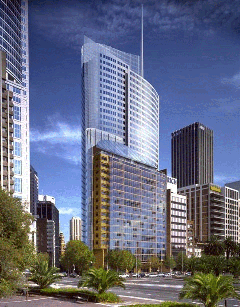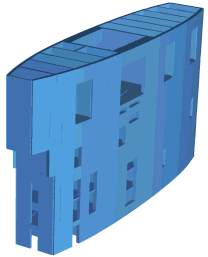Analysis of 200m high office tower at 88 Phillip St, Sydney, Australia
|
Background |
Lend Lease Design Group used Strand7 to perform a structural analysis on
the building frame of the 200m high, commercial tower of 88 Phillip Street,
Sydney, Australia. This high-rise building consists of 48 levels (4 basement
floors and 44 tower floors).
|

|
The building structure is a reinforced concrete frame comprising of a
central core and floor slabs spanning to columns situated at the perimeter. The
project is a joint venture between Lend Lease and the Hong Kong based East Asia
Group. The project has an estimated capital value of AUD550 million and is due
for completion in August, 2000.
|
The core plan geometry is of a lozenge shape. The design of the
tower is novel in that the floor plan increases in size with the height of the
building, so the building appears to lean outward. The architect is the Genoa
based Renzo Piano Building Workshop and the structural engineers are Lend Lease
Design Group.
|
The core has plan dimensions of 40m in length by 9.5m in width at its
extremities. In elevation, the core structure transfers the northern and
southern ends of the building by corbelling out of the main walls. The
perimeter of the floor structure follows the curvature of the core walls. The
tower columns form a perimeter frame with edge beams at each level. The floor
plates span from the core walls to the edge beams utilising post-tensioned band
beams. The beams are designed with notched ends to allow for optimum services
reticulation. Reinforced concrete slabs span between the floor beams.
|
Scope of work
|
A rigorous structural analysis of the tower frame was carried out to comply
with Clause 7.8 of AS 3600. The analysis takes into account the relevant
material properties, geometric effects, three-dimensional effects and
interaction with the foundations.
|
The principal aim of the analysis was to effectively predict the structural
behaviour of the unique shape of the tower frame subjected to various static
and dynamic loading conditions. These loading conditions were generated from
combinations of superimposed dead loads, live loads, wind loads and seismic
loads.
|
Static load combinations complying with the relevant Australian Standards
provided realistic predictions of the actions of the building frame,
particularly due to applied lateral loads and eccentric dead loads.
|
The dynamic response of the structure also needed to be assessed to
evaluate the natural frequencies of the tower frame and consequently the
response of the structure. A linear buckling analysis enabled the determination
of the tower column effective lengths.
|
Statistics
|
Model
|
The finite element model of the commercial tower was prepared via a
sequential procedure. The geometry was directly imported from CAD files. Once
imported, the plan diagram was constructed with beam elements for the core and
floor plate structure.
|
A suitable mesh grading to model the floor in plate elements was developed.
Five plate element properties were used per level to account for the end
notching of the beams and slab thickening around the core. Strand7 allowed the
use of different membrane and bending thicknesses for each plate property. Beam
elements were used to model the perimeter beams. The self weight of the
structure could be determined by assigning plate densities. Superimposed floor
loads and live loads were applied as face pressures to plate elements.
|
Plate elements were used to simulate the facade of the building. The facade
plate elements were a Quad4 type, each node connected to the structural beam
elements. The lateral wind pressures were then applied to the face of these
plate elements.
|

|
Analysis
|
The Linear Static, Natural Frequency and Linear Buckling solvers were used
to evaluate the structural behaviour of the tower frame. Linear static analyses
were used to predict the structural behaviour of the structural elements for a
combination of lateral loads and eccentric vertical loads.
|
The moment distribution of the lateral load between the core and the frame
was also evaluated. It was important that a sensitivity analysis be carried out
to account for the varying stiffness of the slab-core and slab-column
connection.
|
Sub-modelling
|
The sub-modelling feature in Strand7 was used to study the detailed actions
of the structural components in critical areas. This was achieved by using a
much finer mesh in these areas compared to the coarse mesh of the global model.
The sub-modelling feature allowed the bending moments, shear forces and axial
forces to be found for the subsequent design of each structural component using
the results of the global model.
|
A sensitivity analysis was also performed on the model by varying the
dynamic and static moduli of the structural sections. This enabled the range of
possible natural frequencies for the tower to be determined.
|

|

|

|






 Menu
Menu